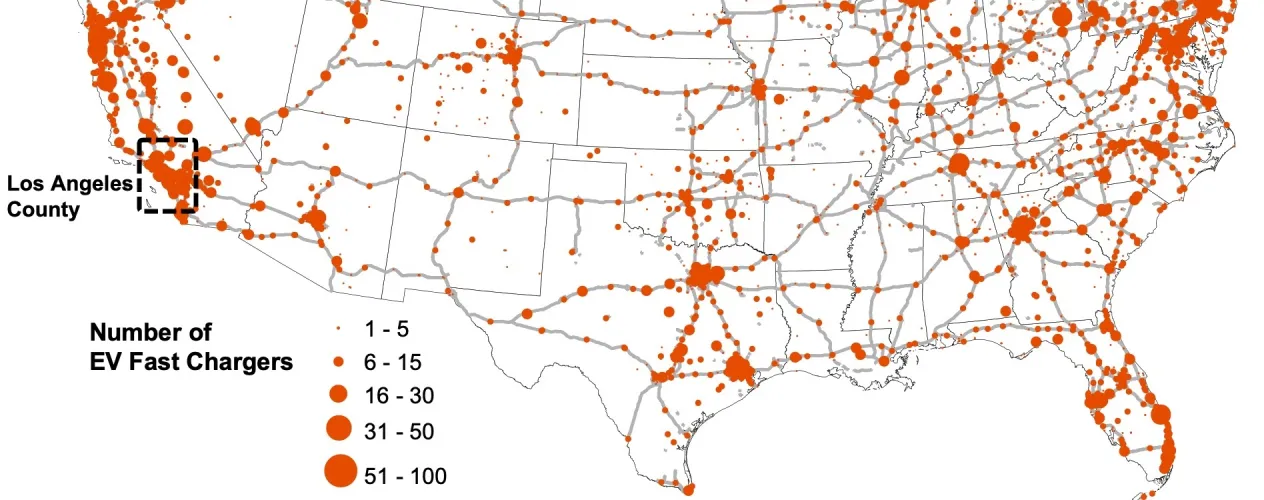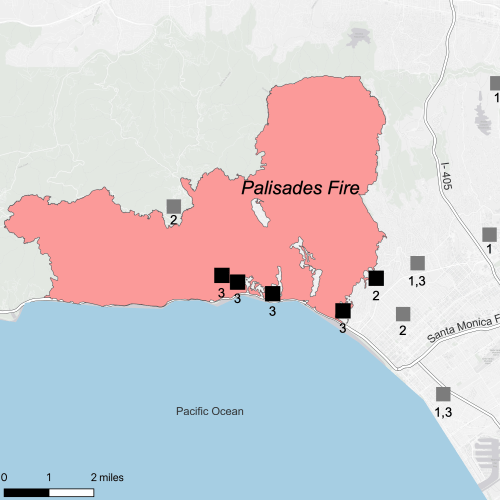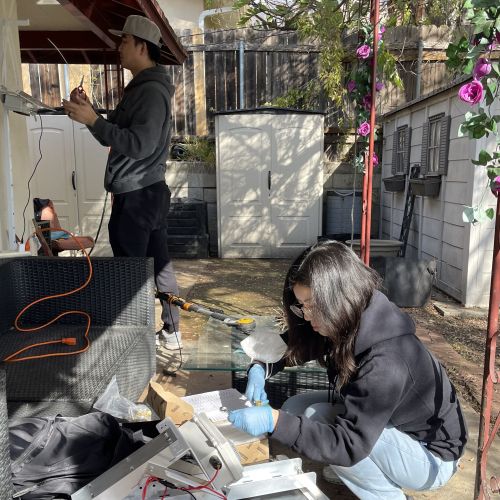UCLA team finds high levels of particulates in air near electric vehicle fast charging stations
The study found pollutant concentrations were significantly higher closer to charging facilities than elsewhere in urban areas.

A team led by UCLA Fielding School of Public Health researchers has found the levels of fine particulate matter in the air near electric vehicle fast charging stations across Los Angeles County are significantly higher than those measured at urban sites without the stations.
The study, “Fine particulate matter emissions from electric vehicle fast charging stations,” was published in the July edition of the peer-reviewed journal Environment International. The researchers, from UCLA Fielding and the UCLA Samueli School of Engineering, found the air near Direct Current Fast Charging (DCFC) stations at 50 locations across the county were higher than those measured at urban “background” sites, without fast charging stations, used for comparison, researchers said.
“For anyone, exposure to fine particles can contribute to health issues, and for those with existing conditions or heightened sensitivity, the risks are even greater,” said Dr. Michael Jerrett, professor in UCLA Fielding’s Department of Environmental Health Sciences and a study co-author. “Because these particles are so small, they can travel deep into your lungs and even enter your bloodstream - potentially leading to serious problems like heart or lung disease.”
The researchers checked for potentially dangerous air particles, known as PM2.5, that measure roughly 2.5 micrometers or less in width—about 30 times smaller than a human hair. At the charging stations, daily concentrations ranged from 7.3 to 39.0 micrograms per cubic meter, while the same analysis at the background sites found concentrations of only 3.6 to 12.4 micrograms per cubic meter.
“Our findings suggest that these tiny particles likely come from particle resuspension around the DCFC’s power cabinets. These cabinets convert electricity from the grid into the direct current needed to charge electric vehicle batteries,” said Dr. Yuan Yao, a UCLA Fielding scholar and first author of the study. “The cabinets also contain cooling systems to prevent the electronics from overheating, and these cooling fans can stir up dust and particles from internal surfaces. That’s what we think might be one of the reasons for the increased pollutant levels we found.”
The study team examined air quality at 50 DCFC stations – with a variety of owners and equipment - across 47 cities in Los Angeles County, performing field measurements in communities from Lakewood north to Santa Clarita, and from Malibu on the coast inland to Pomona. For comparison purposes, the researchers also sampled at gas stations and urban background sites across the county and during the same sampling period.
Among all counties in the United States, Los Angeles County had the highest number of EV fast chargers in operation, totaling 1,938 units of some 9,900 across the state of California as of November 2023. There are some 36,000 such units across the U.S., with 2,200 in Texas, and 2,100 in Florida, respectively.
The result of the Los Angeles County study included measurements as high as 39 and 34 micrograms per cubic meter in cities as far apart as West Hollywood and Santa Clarita, to lower but still concerning measurements of 7.3 and 7.5 micrograms per cubic meter in communities as disparate as Santa Monica and Claremont. The original sources of the particles include a mix of possibilities, ranging from brake and tire wear to dirt and dust, researchers said.
“Transportation electrification is vital to California’s climate goals, and EV charging infrastructure plays a key role in that transition,” said Dr. Yifang Zhu, professor in UCLA Fielding’s Department of Environmental Health Sciences and a lead author of the study. “To fully deliver on its health promises, we must also address unintended emissions from DCFC stations to ensure that clean transportation truly means clean air for all.”
Funding
This work was supported by the University of California Office of the President’s Climate Action under grant number R02CP6948.
Methods
The team researched DCFC locations through the Alternative Fuel Data Center, U.S. Department of Energy (U.S. Department of Energy, Alternative Fueling Station Locator), and cross-referenced with DCFC owners’ networks. To ensure a representative sample, the researchers used a random selection process to include a wide range of cities within the county and avoid clustering.
Samples were obtained using a variety of certified and validated sampling equipment between February and May 2024, and instruments were synchronized to ensure accuracy and consistency in data collection. Statistical analyses followed using standardized processes and software.
Data availability
Data will be made available on request.
================
EV fast chargers are pollutant hot spots
Electric vehicle fast-charging stations are pollutant hot spots, according to a new UCLA study. EV drivers taking a road trip for the long Fourth of July weekend might want to stand back while recharging their batteries: Scientists found the air around EV fast chargers had around twice as much fine particulate matter compared to general urban levels.
While that’s dangerous to breathe in, the good news is that it’s over a small area and relatively easy to avoid. The scientists who measured the air quality believe the chargers aren’t making the pollution, but that it's due to cooling fans inside fast-chargers’ power cabinets kicking up traffic dust deposited by visiting EVs. Fixing it might just be a matter of making a few engineering tweaks to the power cabinets, said the senior author of the study, UCLA environmental health professor Yifang Zhu:
- “There’s no healthy amount of fine particulate matter to breathe, and the amount around fast chargers for electric vehicles is about twice as high as background levels of PM 2.5 (fine particulate matter). We tested 50 fast-chargers across L.A. and found higher particle levels near their power cabinets, with even higher levels of metal tracers from brake and tire particles.”
- “EVs remain a vast improvement over combustion vehicles, and our own studies show that transportation electrification cleans the air for everyone. These unintended emissions by fast chargers should be addressed, such as by adding air filters to prevent redistribution of fine particulate matter.”
- “In Los Angeles, the urban background PM 2.5 is 7 to 8 micrograms per cubic meter. Urban traffic sites in L.A., like freeways or busy intersections, range around 10 to 11. We measured a few gas stations at about 12. Fast chargers average 15, and sometimes peaked as high as 200.”
- “We measured at different distances from the chargers. The high measurements [15-200] were taken at the chargers’ power cabinets. Fortunately, a few meters away, the concentrations drop quite a bit. A few hundred meters away, there’s no noticeable difference compared to background levels of pollution.”
- “The main concern is for EV drivers. When they charge their car at a fast charger, they’re exposed to elevated levels of harmful particulate matter. But they can mitigate their exposure by being inside their car running the climate system, or by going indoors or to a nearby open space.”
Media are encouraged to quote from Zhu’s comments or to reach out to request an interview with her, her co-authors, or other UCLA climate experts. Zhu and her colleagues are currently testing 24 additional locations, comparing air quality at gas stations and neighboring fast chargers. Zhu is a professor of environmental health sciences at UCLA’s Fielding School of Public Health, with expertise in air pollution, emissions and exposure assessment.

